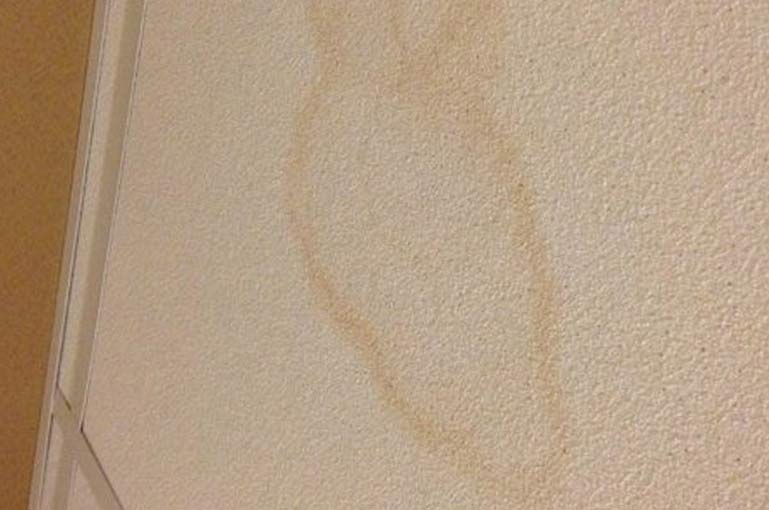When I renovated my house recently, the one thing I made sure was to get stains off ceiling. This is because of an experience I recently had.
One of my friends wanted to sell her house in the suburbs and move to a location downtown because it was closer to the school her daughters attended. Yet, she was unable to get a good price for it. The house was just about four years old and was in good condition, with only a few repairs needed.
However, the potential buyers always noticed the water stain on drywall and considered it a sign that the roof was leaking. Overhauling the roof could be expensive and most buyers did not want to invest a lump sum, soon after buying a home.
Although I do not have any plans of selling my house as yet, I did feel that it was a matter that should be looked into. If the yellow stain on ceiling persists, they would signify that the house is in poor condition, and creates an equally poor impression on your guests when they come to visit. You don’t want them to think you don’t care about your house.
Causes Of Water Stain On Wall Or Roof
The key to fixing the stain is to understand its underlying cause.
Leaking roof
This is, of course, the most common cause behind the roof stain. During monsoons or even during winters- in case you live in a region which experiences snowfall- moisture can seep through the roof and stain the ceiling and the walls below it.
You can prevent this from happening by installing waterproof flooring on the terrace above. You could also opt for slated roofs so that the water or melted snow just flows down instead of standing in puddles on the roof. Once you prevent water dripping, the battle is half won.
Leakage in the room-heating pipes
If pipelines are running behind the walls or under the roof carrying hot water, and if they tend to leak, then similar brown patch or yellowish stains might appear on the walls or ceiling.
Many households do not use a separate room heater for room heating to save on electricity, and instead, use the hot water pipes to keep the rooms warm as they run through the ceiling, behind the walls or under the floor. Fixing the pipes can reduce the propensity of stains.
Leaking toilets
Bathroom ceilings are more likely to develop stains due to the constant presence of water. If you have a toilet or bathroom on the floor above, then toilet leaking through ceilings is another cause for stains.
Water from the basin, toilet, shower, or bathtub could seep through the floor tiles for lack of grouting and stain the ceiling below. Make sure you check the plumbing and tiles of your toilet frequently.
How To Get Rid Of Water Stains On Ceiling?
Please note at the very beginning that the stains are almost always a result of leakage.
So, if you simply try to cover up the stain without addressing the root cause, then not only will the stain return in the future, but the excess moisture could also lead to structural damage, result in mildew and fungus or worse, cause accidents by interfering with the wiring system, resulting in short circuits and fire hazards.
You should make it a habit to regularly check out places like garage ceilings, which are not always thoroughly inspected.
Here are some options you can try to repair water stain on ceiling, only after you have addressed the cause of the problem, which includes repairing leaking plumbing, loose shingles on the roof, or malfunctioning radiators.
1. Try A Homemade Cleaning Solution
- First, make a homemade cleaning solution, consisting primarily of detergent and bleach.
- Mix one part of bleach with two parts of the detergent and mix it with five parts of water.
- Then, take a cloth and rub the stained area to get rid of the loose dirt and cobwebs from the damp ceiling corner.
- Next, apply the mixture on the stain and let it sit for an hour.
- Wipe off the humidity stain with a cloth dipped in a bleach solution. Be sure to don protective masks and gloves while handling the solution.
- This will lighten the stain considerably.
- Thereafter, let the area dry completely.
- Then, get some stain-blocking primer from the hardware store and apply two to three coats, making sure that the previous coat has dried completely before you apply the next one.
- Never use paint to cover water stains directly without using a primer, because paint alone does not stick to concrete or drywall very well.
- Try to use an oil-based primer as it will also give you added protection against mildew.
- Use a roller brush to apply the primer evenly.
- Finally, choose the paint that closely matches the color of the ceiling and apply two coats. Try to avoid white paint to cover water stains as there are more chances of the stain showing through later.
You will get a brand new ceiling within a few days!
In case you are allergic to bleach, you can also buy a commercial ceiling stain remover.
2. Use Sealant For Ceiling Repair Water Damage
Use the ceiling sealant in all the areas behind or near the spot where the stains occur the most. The sealant, once dry, will act as a barrier and prevent moisture from seeping through drywall or plywood partitions. However, these sealants are mostly good for temporary repairs and it is best if you eventually come up with a permanent plan to clean up ceiling patch for good.
To remove water stains from ceiling without painting, you have to take more drastic steps, like cutting off the drywall. Persistent leakage can make a hole right through the wall. You should consider replacing the drywall, or at least the sodden section to prevent further damage.
- Mark the portion of the drywall which is stained, first taking care to repair the ceiling leak.
- Then, make an outer perimeter around the stain, with a marker. This will be the guiding line along which to cut off the damaged drywall.
- Use a keyhole saw to cut through the drywall.
- Make sure that the entire affected area is removed and no damp patches of water damaged ceiling are left behind.
- Use a water stain spray to remove any mild or light patches that might have nerved out.
- Then, use a drywall joint compound to fill the gap.
- Use industrial glue to hold it in place.
- Ensure that the replacement drywall is cut to size and there are no gaps between the new and the existing drywall. These gaps often end up becoming breeding ground for insects.
- You can also apply putty to seal off any gaps, just to be sure.
- Then, use spray paint or roller brush and paint to even out the surface and to prevent any noticeable change in color between old and new drywall.
In comparison, water damaged ceiling tiles are easier to clean. Tiles have a slick surface, which is why stains cannot hold on to them as strongly as they do on concrete or wood surfaces. Scrubbing the tiles with bleach solution often does the work, and it does not even require a lot of scrubbing in most cases.
Just in case the stain seems persistent, you can always replace the couple of tiles that resulted in the water spot on ceiling- provided your tiles do not have a very unique design, which would make them more difficult to replace.
To treat ceiling water stains, you should always have certain tools handy, especially if you live in an old house or in a region where it rains frequently. A step ladder is a must. Then you will need protective gloves and goggles, a long-handled brush, stain removers, and cloth.
If you address ceiling moisture spots as soon as you spot them, then you can do most of the repair yourself, without having to incur extra costs by summoning a professional when the damage is too far gone.
3. Treating Molds On The Ceiling:
Water stain on ceiling mold can create more problems. Mold is unhealthy and thrives in damp and dark spaces, which is why they occur in places like the basement and cellars. The first criterion to obtain a mold-free home is proper ventilation. Let natural light and fresh air fill every corner of your house as much as possible.
In case you see mold in bathroom corners and ceilings, then keep the shower doors open to get rid of the steam. If that is not possible, consider using a dehumidifier to avoid condensation.
In case the mold has already settled in, you can clean the stain in the following manner.
- Scrape off the mold with a spatula. Wearing a facemask, goggles, and gloves is a must.
- Once the excess mold is gone, spray a solution made of one part borax, two parts of vinegar and four parts of bleach. Mix all this with about half a cup of warm water.
- Spray the solution and allow it to rest for an hour.
- Wipe off the stain with an abrasive cloth. Repeat the process if needed.
- Finally, apply two coats of primer and a coat of paint to complete the procedure.
These are some of how I got rid of the brown stain on ceiling from different parts of my house and hope they work for you too.
Do you have any other trick up your sleeve? I would love to know about them.









Leave a Reply
View Comments